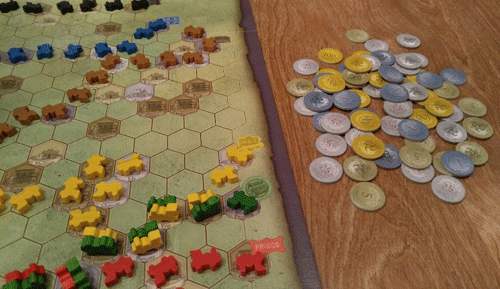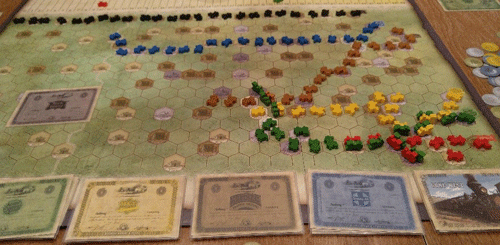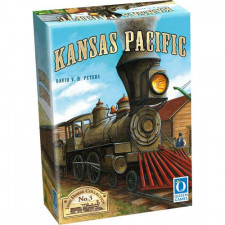Kansas Pacific Review
on Jan 17, 2017
I still remember my very first encounter with a Winsome game. One of the guys in my game group brought a game packaged in a plastic clamshell, like the kind you usually throw away after opening it. Inside the plastic was what looked like a prototype. The “board†consisted of some hexes printed on two pieces of glossy paper that are placed next to each other. The only components were a handful of wooden cubes and some text printed on colored construction paper. I was dumbfounded. What was this? As it turns out, it was a train game and not anywhere close to being like Ticket to Ride.
If you’ve never played one of these types of games, they generally have a few things in common: laying track to increase a company’s income, buying shares, and getting dividends. Whoever has the most money at the end wins. These games typically involve no luck and a lot of arithmetic. Usually these games have a limited print run, but Queen Games has taken several of the Winsome games and given them a makeover, à la a late 90’s teen rom-com. Kansas Pacific is the latest to get this nerd-to-hot-girl treatment.

From geek to chic, just by removing the glasses. (Photo credit for left image: jdludlow on BGG)
One of the things that blew my mind when I played the original version of Kansas Pacific was that there were no player turns; the companies had turns. Whoever is the president, based on having the most shares, gets to decide what actions the company will do. One of these is putting a share up for auction – a fairly standard element of most train games. When you put a share up for auction, the money spent to win it goes into the company’s coffers, which allows the railroad to pay for building more track later on. However, you want to make sure your shares of the various companies aren’t getting diluted, otherwise the payouts won’t be worth the investment. This means you’re always needing to calculate whether or not it’s really worth outbidding your opponents. Do you deny them a share or to just let them have it in the hope that their investment won’t end up coming back to them? This kind of min/maxing math can be tricky and, at least at first, fairly opaque.

“Clearly others play this better than us given how many hundreds are there.†– actual quote
Another unique aspect of Kansas Pacific is the Land Grant and Go West options. The Land Grant option allows the railroad president to purchase 10 additional locomotives if the track has passed the denoted line on the board. These extra trains can be a huge help for increasing the company’s value by building into additional cities or sprinting westward when there otherwise wouldn’t have been enough. This is important because once a company has hit one of the westernmost hexes, its president can Go West, boosting the company’s value by $20, which is huge. Though the railroad can no longer sell shares or build track, that company pays dividends every time its turn comes up. If you’ve bought shares in this company, you’ve got a railroad sugar daddy for the remainder of the game.
Of course, I’ve left out several other details to the game, but this is the general idea of how things work. The game will end when one of several conditions is met regarding how many tracks, shares, or Gone Wests have happened across companies. The game will also end after 8 rounds if the other conditions have not been met.

Everyone tries to stand up the trains at first, but quickly gives up.
Regardless of what forces the games end, it will clock in at around 2 hours or so. It’s not that the actions themselves are that long, but there are a lot of moving parts. If there’s an auction going on, you have to wait until everyone has bid/passed. There’s also a lot of valuation going on in the midst of the auctions as players are calculating whether or not a share at a certain price is worth it to them or not. This kind of deliberation, no matter how fast of a player you are, is inherent and necessary to the game and playing it well. However, as I mentioned above, it can be difficult to know exactly how to approach any of the given options in the game, especially for those who may be new to a train game. As such, it is likely that more experienced players will outperform newer ones. Moreover, the game is not very forgiving. Maybe you didn’t grab a share at the right time or nobody else invested in your company so it went broke. Too bad. The game expects you to be smart. If you fall behind, you’re unlikely to catch up. Consequently, the game is going to be best with players of equal skill and approach. It relies heavily on players keeping one another in check.
As an introduction to train games, Kansas Pacific may not be the best choice. There are some easier, faster paced, and more straightforward ones to start with. It’s also important to note that the game is dry. No matter how much lipstick Queen put on the design, it’s still all about crunching numbers and putting cubes (well, trains) on hexes. Overall, the game is interesting, but not one that is necessarily enjoyable the whole time. The work to fun ratio is going to vary greatly based on your preferences. However, if you’re already familiar with some other Winsome or Queen train game titles, Kansas Pacific is worth checking out.

 Customer Support
Customer Support  Subscribe
Subscribe 




 Account
Account  Wishlist
Wishlist 

